
Border Patrol agents apprehended 1,036 men, women and children trying to cross the border in El Paso, Texas, last week. Immigration numbers have not reached levels of the early 2000s, but Customs and Border Protection officials say more and more migrants are families and children. (Photo by Agent Edward Butron/U.S. Customs and Border Protection)
WASHINGTON – The number of migrants apprehended at the southern border surged to 144,278 in May, bringing the total for the first eight months of fiscal 2019 to 676,315, already more than any full year in the last decade.
More than 20,000 of those apprehensions were in Arizona, according to U.S. Customs and Border Protection, which said agents in the Yuma and Tucson sectors had stopped 99,472 migrants through the end of May.
The new numbers, released Wednesday, portray a system that is “bursting at the seams” and “unsustainable,” border officials said, particularly as they grapple with ever-growing numbers of families and children showing up.
“This is unprecedented,” Pima County Sheriff Mark Napier said Thursday. “It is straining our system into breaking.”
Napier said the influx of immigrants is not just a law enforcement problem, but is a particular strain on the nonprofits and nongovernmental organizations that aid those migrants.
An official at the Kino Border Initiative agreed that the newcomers are a strain, but she said nonprofits like hers intend to do everything they can to help families fleeing violence and poverty in Central America.
“The numbers reflect that over the course of a decade, the conditions of Central America really haven’t improved,” said Joanna Williams, Kino’s director of education and advocacy. “So even the people who, in the past, wouldn’t have thought to migrate find themselves obligated to come to the U.S.”
The new report comes just days before President Donald Trump has said he will impose tariffs on Mexican goods unless that country does more to stop the flow of migrants to the southern border of the U.S.
“President Trump realizes that he must take drastic measures to do what Congress is unwilling to do,” Rep Andy Biggs, R-Gilbert, said in a prepared statement. “This is a national emergency, and our leaders must take action to protect Americans and the sovereignty of our great nation.”
But Williams attributed much of the blame to the administration and its immigration policy.
“The administration hasn’t had a coherent policy related to immigration, and every week it changes,” she said. “When the administration tries policy or makes announcements in an attempt to deter immigration, in an ironic sense it actually makes people think, ‘This might be my only chance.'”
Despite the surge, apprehensions at the southern border are still smaller than they were in the early 2000s, when the numbers regularly topped 1 million immigrants.
But unlike then, many of the migrants being stopped now are families and children, what one CBP official called “dramatically different from anything we’ve ever faced” because of the demographics of those showing up at the border.
In a conference call with reporters to release the new numbers Wednesday, CBP Law Enforcement Operations Chief Brian Hastings described the makeup of those apprehended at the border in May.
“Over 11,000 apprehensions were unaccompanied alien children, that’s a 29 percent increase over our already record numbers in April,” Hastings said, according to a transcript of the call. “Over 84,000, or nearly 64 percent of our apprehensions, were family units.”
Biggs said the numbers are proof that the “crisis at our southern border continues to escalate.”
“I implore the administration to immediately exhaust all remaining executive actions to slow this crisis,” said Biggs, who joined other lawmakers last month urging CBP to take measures that included more training for officers processing asylum claims, limits on parole and a reduction in work authorizations for immigrants.
But Williams said such steps would do little to deter migrants who feel forced to come here to escape the situation in their home countries, mostly in Central America. She described a conversation with a migrant in Kino’s women’s shelter who “fled from Honduras and she never imagined she would end up migrating.”
“She said, ‘I saw other people leaving and I couldn’t understand why they left but there’s so much violence and poverty that pushes us,'” Williams quoted the woman as saying. “She said, ‘I don’t think the president understands why it is that we leave.'”
-Cronkite News video by Amanda Slee
